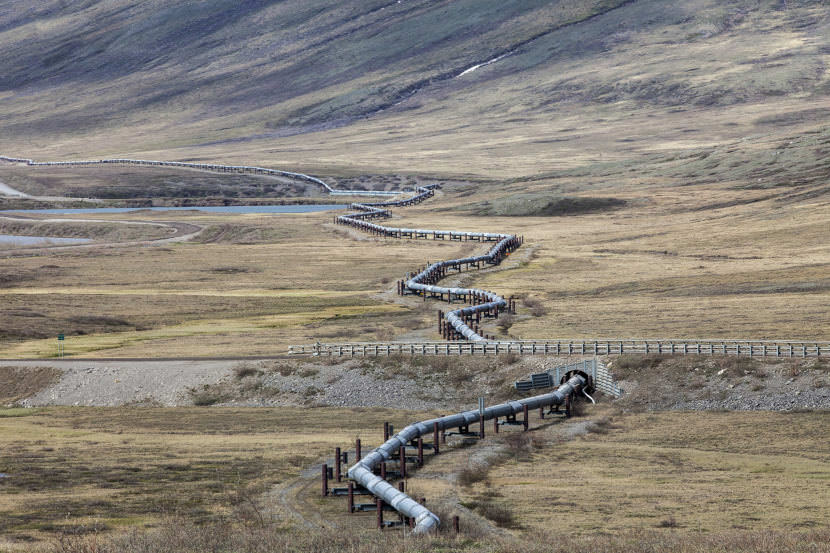
Oil prices spiked on Jan. 3 after news broke that the U.S. killed Iranian Gen. Qasem Soleimani in a drone strike in Iraq — and again last week, when Iran retaliated by firing missiles at a U.S. military base in Iraq.
But after a short shock in prices, Alaska North Slope crude has settled at a lower price than it was before tensions boiled over.
Analysts say that’s because tension in the Middle East just doesn’t have the same impact on the market for Alaska’s oil that it used to.
Roger Marks is a retired state petroleum economist. He worked for Alaska’s Department of Revenue, watching what was happening politically — and the oil market’s response to it — for 25 years.
“I was there when Iraq invaded Kuwait,” he said. “I was there when the U.S. invaded Iraq, both times.”
At the beginning of his career, disruptions in the Middle East caused a lot of sustained turmoil in the oil market. Marks said during the first Gulf War in the early ’90s, prices jumped up and stayed up for almost a year.
But ask him what oil prices are going to do at any one point, and he’ll laugh.
“You know, nobody knows. Anybody who tells you they know, that’s a sign they don’t know what they’re talking about,” he said.
Oil prices did jump up: Alaska North Slope crude got to nearly $71 on Jan. 7. But the price dropped pretty dramatically the next day. And that, in part, is because the energy market is very different now than it was a decade ago.
Marks points to the attacks on an oil field and processing facility in Saudi Arabia in September that knocked out more than 5% of the world’s daily oil production.
It was the biggest disruption to global oil supply in decades, and Alaska North Slope crude prices jumped to their highest in months — adding nearly $8 — for one day. Then they dropped right back down.
And for Alaska, a one-day spike in oil prices doesn’t really mean much for the state’s bottom line.
But that dynamic — the oil market shrugging off attacks on oil and gas infrastructure in the Middle East — is one that some economists caution is probably not going to last forever.
Richard Nephew is a senior research scholar at the Center on Global Energy Policy at Columbia University. He used to work for the U.S. Department of State, where he was the lead sanctions expert during the negotiations with Iran under former President Barack Obama.
Nephew said there are three reasons the oil market isn’t as reactive to geopolitics in the Middle East as it used to be.
Right now, there’s enough supply that there’s kind of a sense that small, short-term disruptions can be handled.
“There’s enough oil coming from other sources — Alaska being a part of this, but also shale oil and Venezuela and Libya and all those places,” Nephew said. “There is enough oil that’s just floating around that disruptions in any one of those places can be made up by supply in many other places.”
The second reason? Global demand for crude oil isn’t growing like it used to. And third, recent disruptions in supply have been short-lived. After the attack in September, Saudi Arabia brought its oil production back online within a few days.
“Here, you know, you had a spike, and then both Trump and the Iranians said, ‘We’re going to leave the military responses here, so you see things relax,'” he said.
Nephew said he thinks the people driving the oil markets have gotten complacent. They worry about the possibility of a major disruption in supply in the Middle East, but “they’ve kind of internalized this idea of ‘but that probably won’t happen.’”
Nephew said that false confidence is a big problem because, right now, the expectation is that there will be sharp swings in prices and then things will calm down.
But he points out that while Iran may have discounted further military action, there is still the possibility that the country could retaliate. For instance, if Iran were to shut down the Strait of Hormuz that separates it from the Arabian Peninsula — where more than than 20% of the world’s supply of oil comes through — that could cause a major disruption.
“The day that we don’t have things calm down, the day that we do have sustained production losses of 5 million barrels a day or something like that — that’s when you’re going to see a tremendous rise in prices, and it probably will be sustained for a pretty long time,” he said.
To balance Alaska’s budget, prices would have to hit $91 a barrel and stay there, according to the state’s Department of Revenue.
